Detailed Evaluation of the Supplemental Nutrition Assistance Program
VerifiedAdded on 2023/06/09
|22
|6439
|175
Report
AI Summary
This report provides a comprehensive evaluation of the Supplemental Nutrition Assistance Program (SNAP), formerly known as the Food Stamp Program. It begins with an introduction to SNAP, its purpose of providing food assistance to low-income households, and its administration by the United States Department of Agriculture. The report then delves into the program's purpose and worth, highlighting its role in combating hunger and promoting economic productivity. It examines the data collection and analysis processes, including eligibility criteria based on income and other factors, and the program's structure, including its federal oversight and local administrative offices. The report also discusses the stakeholders involved, the benefits provided, and potential program changes. Finally, it offers recommendations for improving SNAP in the future, based on an understanding of its current status and challenges. The report analyzes SNAP's structure, eligibility, benefits, and work requirements. The report also covers the data collected by SNAP, like household resources, the pilot studies undertaken, and the analytic methods used during the pilot studies. The report concludes by providing possible recommendations that can be used to improve SNAP in the future.
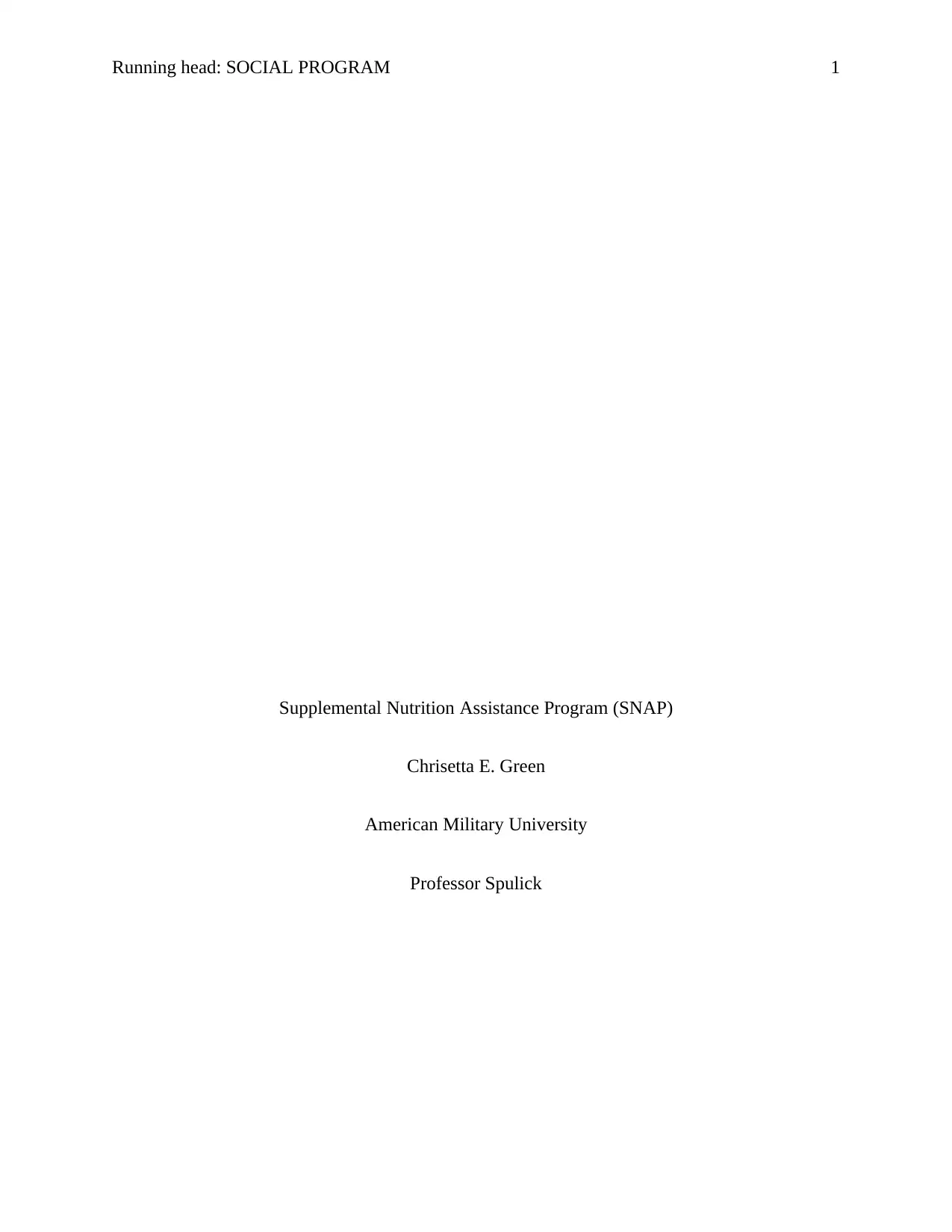
Running head: SOCIAL PROGRAM 1
Supplemental Nutrition Assistance Program (SNAP)
Chrisetta E. Green
American Military University
Professor Spulick
Supplemental Nutrition Assistance Program (SNAP)
Chrisetta E. Green
American Military University
Professor Spulick
Paraphrase This Document
Need a fresh take? Get an instant paraphrase of this document with our AI Paraphraser
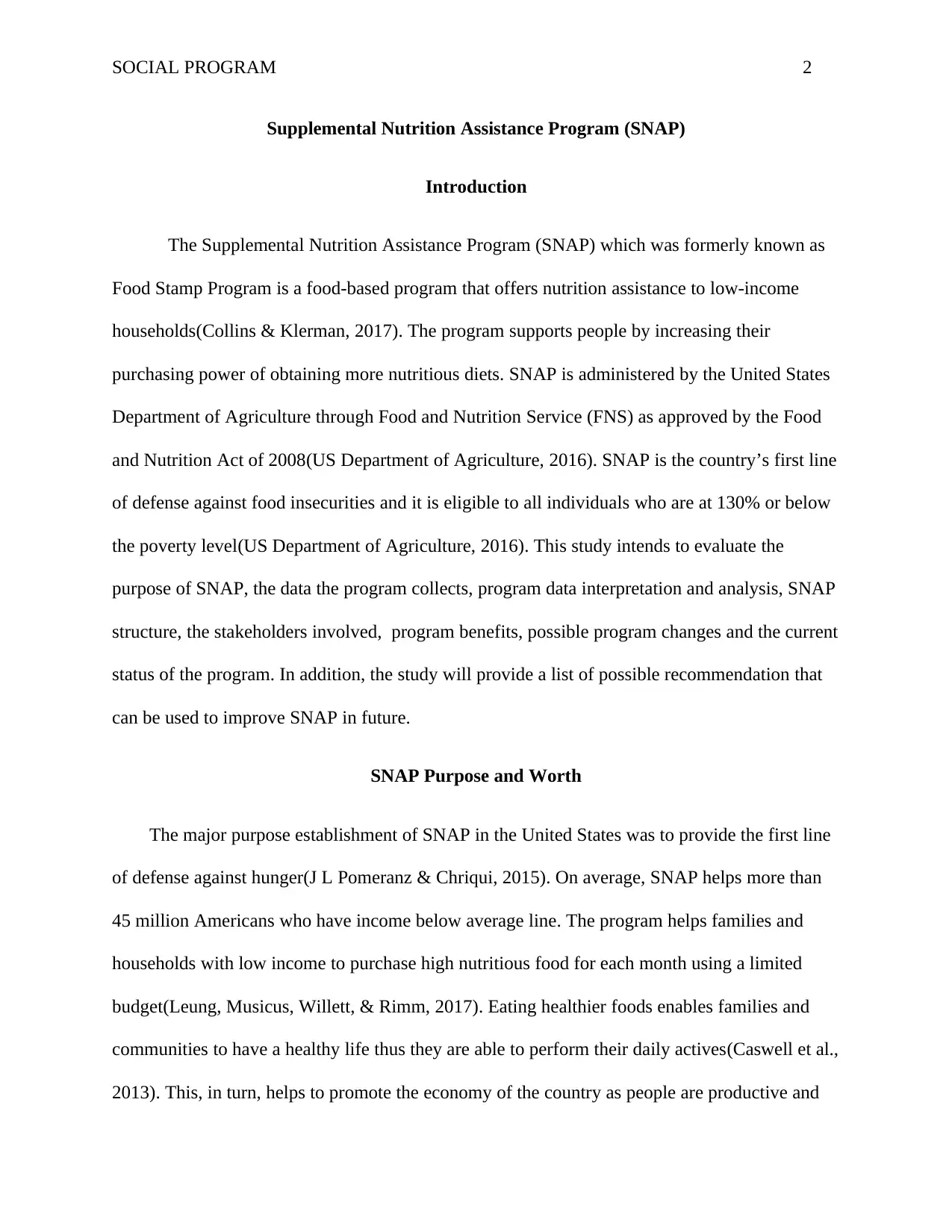
SOCIAL PROGRAM 2
Supplemental Nutrition Assistance Program (SNAP)
Introduction
The Supplemental Nutrition Assistance Program (SNAP) which was formerly known as
Food Stamp Program is a food-based program that offers nutrition assistance to low-income
households(Collins & Klerman, 2017). The program supports people by increasing their
purchasing power of obtaining more nutritious diets. SNAP is administered by the United States
Department of Agriculture through Food and Nutrition Service (FNS) as approved by the Food
and Nutrition Act of 2008(US Department of Agriculture, 2016). SNAP is the country’s first line
of defense against food insecurities and it is eligible to all individuals who are at 130% or below
the poverty level(US Department of Agriculture, 2016). This study intends to evaluate the
purpose of SNAP, the data the program collects, program data interpretation and analysis, SNAP
structure, the stakeholders involved, program benefits, possible program changes and the current
status of the program. In addition, the study will provide a list of possible recommendation that
can be used to improve SNAP in future.
SNAP Purpose and Worth
The major purpose establishment of SNAP in the United States was to provide the first line
of defense against hunger(J L Pomeranz & Chriqui, 2015). On average, SNAP helps more than
45 million Americans who have income below average line. The program helps families and
households with low income to purchase high nutritious food for each month using a limited
budget(Leung, Musicus, Willett, & Rimm, 2017). Eating healthier foods enables families and
communities to have a healthy life thus they are able to perform their daily actives(Caswell et al.,
2013). This, in turn, helps to promote the economy of the country as people are productive and
Supplemental Nutrition Assistance Program (SNAP)
Introduction
The Supplemental Nutrition Assistance Program (SNAP) which was formerly known as
Food Stamp Program is a food-based program that offers nutrition assistance to low-income
households(Collins & Klerman, 2017). The program supports people by increasing their
purchasing power of obtaining more nutritious diets. SNAP is administered by the United States
Department of Agriculture through Food and Nutrition Service (FNS) as approved by the Food
and Nutrition Act of 2008(US Department of Agriculture, 2016). SNAP is the country’s first line
of defense against food insecurities and it is eligible to all individuals who are at 130% or below
the poverty level(US Department of Agriculture, 2016). This study intends to evaluate the
purpose of SNAP, the data the program collects, program data interpretation and analysis, SNAP
structure, the stakeholders involved, program benefits, possible program changes and the current
status of the program. In addition, the study will provide a list of possible recommendation that
can be used to improve SNAP in future.
SNAP Purpose and Worth
The major purpose establishment of SNAP in the United States was to provide the first line
of defense against hunger(J L Pomeranz & Chriqui, 2015). On average, SNAP helps more than
45 million Americans who have income below average line. The program helps families and
households with low income to purchase high nutritious food for each month using a limited
budget(Leung, Musicus, Willett, & Rimm, 2017). Eating healthier foods enables families and
communities to have a healthy life thus they are able to perform their daily actives(Caswell et al.,
2013). This, in turn, helps to promote the economy of the country as people are productive and
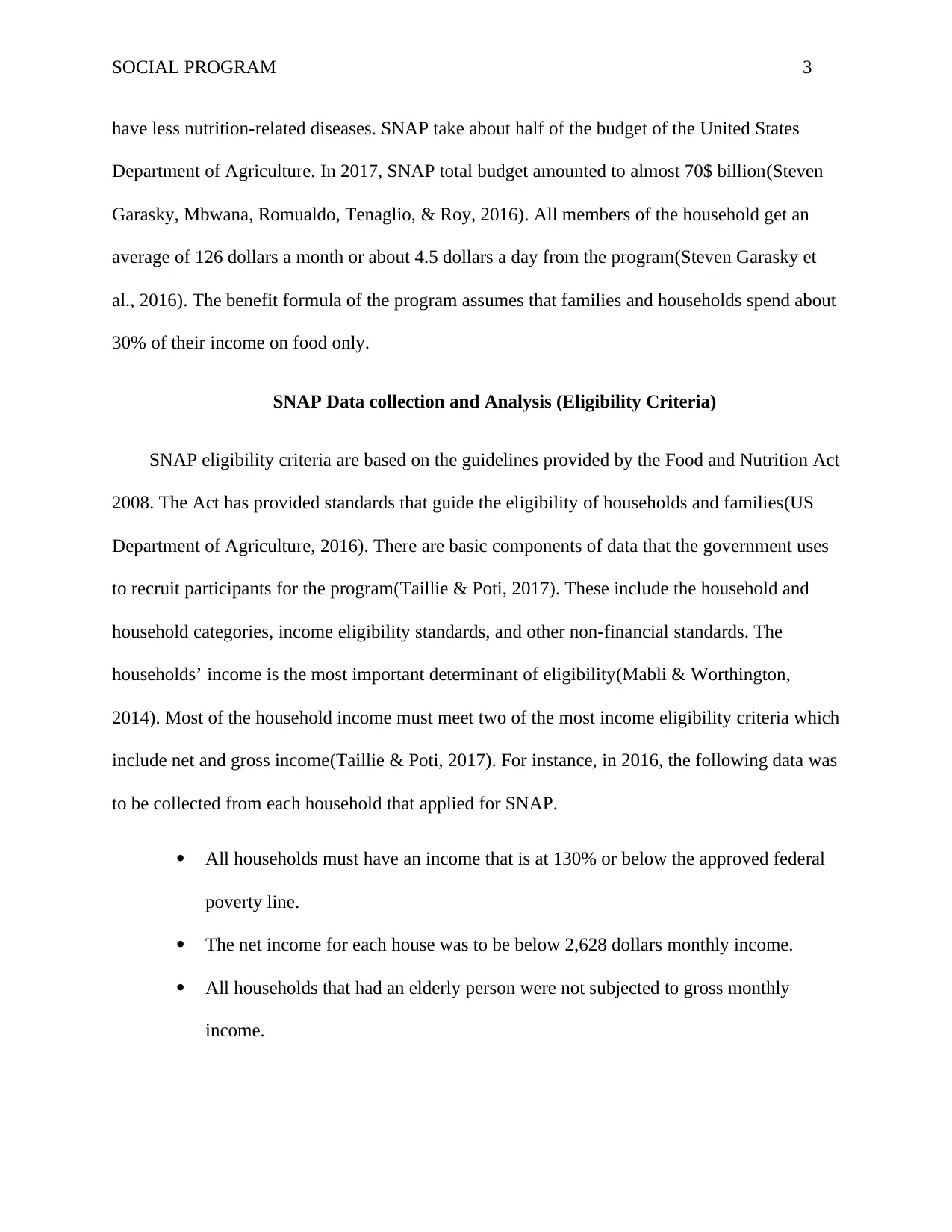
SOCIAL PROGRAM 3
have less nutrition-related diseases. SNAP take about half of the budget of the United States
Department of Agriculture. In 2017, SNAP total budget amounted to almost 70$ billion(Steven
Garasky, Mbwana, Romualdo, Tenaglio, & Roy, 2016). All members of the household get an
average of 126 dollars a month or about 4.5 dollars a day from the program(Steven Garasky et
al., 2016). The benefit formula of the program assumes that families and households spend about
30% of their income on food only.
SNAP Data collection and Analysis (Eligibility Criteria)
SNAP eligibility criteria are based on the guidelines provided by the Food and Nutrition Act
2008. The Act has provided standards that guide the eligibility of households and families(US
Department of Agriculture, 2016). There are basic components of data that the government uses
to recruit participants for the program(Taillie & Poti, 2017). These include the household and
household categories, income eligibility standards, and other non-financial standards. The
households’ income is the most important determinant of eligibility(Mabli & Worthington,
2014). Most of the household income must meet two of the most income eligibility criteria which
include net and gross income(Taillie & Poti, 2017). For instance, in 2016, the following data was
to be collected from each household that applied for SNAP.
All households must have an income that is at 130% or below the approved federal
poverty line.
The net income for each house was to be below 2,628 dollars monthly income.
All households that had an elderly person were not subjected to gross monthly
income.
have less nutrition-related diseases. SNAP take about half of the budget of the United States
Department of Agriculture. In 2017, SNAP total budget amounted to almost 70$ billion(Steven
Garasky, Mbwana, Romualdo, Tenaglio, & Roy, 2016). All members of the household get an
average of 126 dollars a month or about 4.5 dollars a day from the program(Steven Garasky et
al., 2016). The benefit formula of the program assumes that families and households spend about
30% of their income on food only.
SNAP Data collection and Analysis (Eligibility Criteria)
SNAP eligibility criteria are based on the guidelines provided by the Food and Nutrition Act
2008. The Act has provided standards that guide the eligibility of households and families(US
Department of Agriculture, 2016). There are basic components of data that the government uses
to recruit participants for the program(Taillie & Poti, 2017). These include the household and
household categories, income eligibility standards, and other non-financial standards. The
households’ income is the most important determinant of eligibility(Mabli & Worthington,
2014). Most of the household income must meet two of the most income eligibility criteria which
include net and gross income(Taillie & Poti, 2017). For instance, in 2016, the following data was
to be collected from each household that applied for SNAP.
All households must have an income that is at 130% or below the approved federal
poverty line.
The net income for each house was to be below 2,628 dollars monthly income.
All households that had an elderly person were not subjected to gross monthly
income.
⊘ This is a preview!⊘
Do you want full access?
Subscribe today to unlock all pages.

Trusted by 1+ million students worldwide
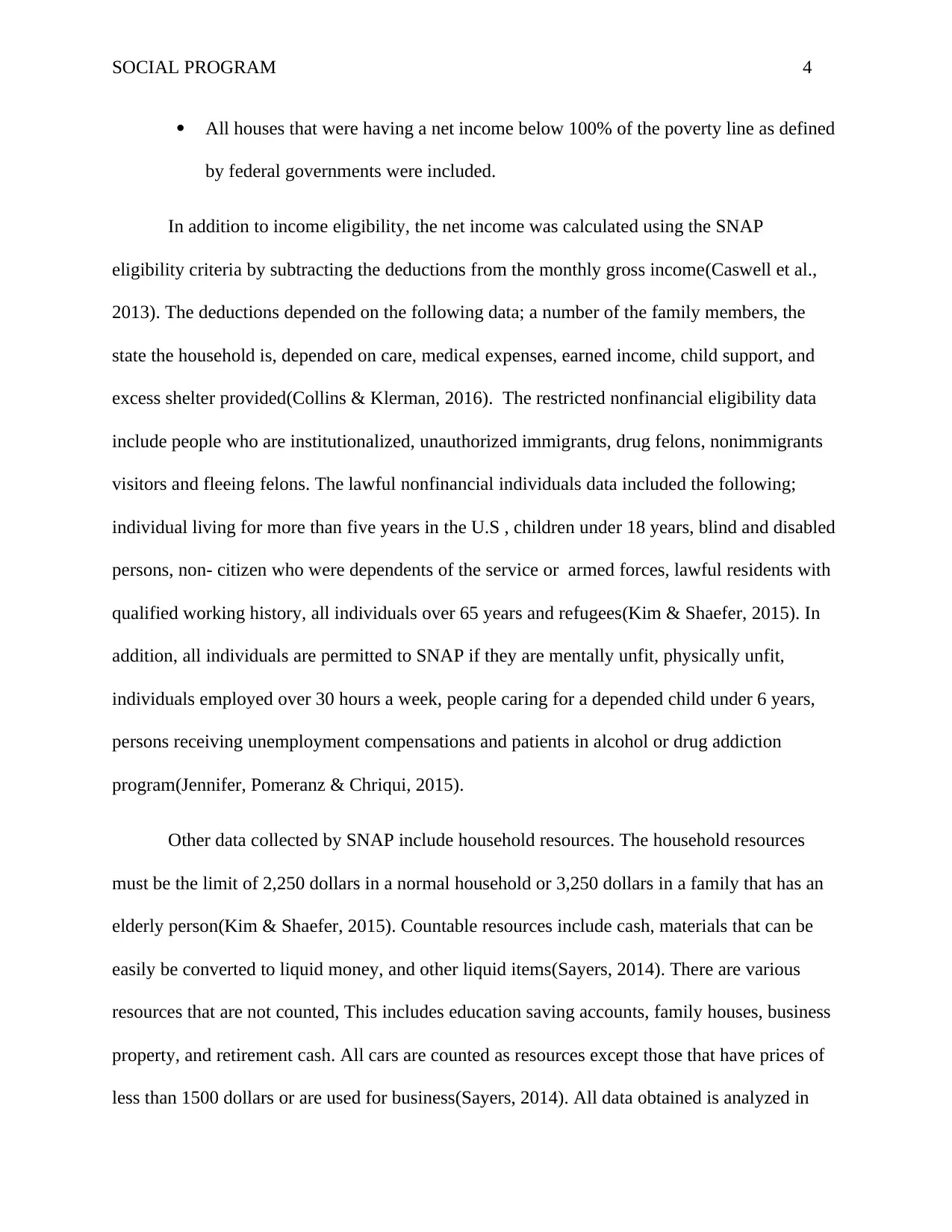
SOCIAL PROGRAM 4
All houses that were having a net income below 100% of the poverty line as defined
by federal governments were included.
In addition to income eligibility, the net income was calculated using the SNAP
eligibility criteria by subtracting the deductions from the monthly gross income(Caswell et al.,
2013). The deductions depended on the following data; a number of the family members, the
state the household is, depended on care, medical expenses, earned income, child support, and
excess shelter provided(Collins & Klerman, 2016). The restricted nonfinancial eligibility data
include people who are institutionalized, unauthorized immigrants, drug felons, nonimmigrants
visitors and fleeing felons. The lawful nonfinancial individuals data included the following;
individual living for more than five years in the U.S , children under 18 years, blind and disabled
persons, non- citizen who were dependents of the service or armed forces, lawful residents with
qualified working history, all individuals over 65 years and refugees(Kim & Shaefer, 2015). In
addition, all individuals are permitted to SNAP if they are mentally unfit, physically unfit,
individuals employed over 30 hours a week, people caring for a depended child under 6 years,
persons receiving unemployment compensations and patients in alcohol or drug addiction
program(Jennifer, Pomeranz & Chriqui, 2015).
Other data collected by SNAP include household resources. The household resources
must be the limit of 2,250 dollars in a normal household or 3,250 dollars in a family that has an
elderly person(Kim & Shaefer, 2015). Countable resources include cash, materials that can be
easily be converted to liquid money, and other liquid items(Sayers, 2014). There are various
resources that are not counted, This includes education saving accounts, family houses, business
property, and retirement cash. All cars are counted as resources except those that have prices of
less than 1500 dollars or are used for business(Sayers, 2014). All data obtained is analyzed in
All houses that were having a net income below 100% of the poverty line as defined
by federal governments were included.
In addition to income eligibility, the net income was calculated using the SNAP
eligibility criteria by subtracting the deductions from the monthly gross income(Caswell et al.,
2013). The deductions depended on the following data; a number of the family members, the
state the household is, depended on care, medical expenses, earned income, child support, and
excess shelter provided(Collins & Klerman, 2016). The restricted nonfinancial eligibility data
include people who are institutionalized, unauthorized immigrants, drug felons, nonimmigrants
visitors and fleeing felons. The lawful nonfinancial individuals data included the following;
individual living for more than five years in the U.S , children under 18 years, blind and disabled
persons, non- citizen who were dependents of the service or armed forces, lawful residents with
qualified working history, all individuals over 65 years and refugees(Kim & Shaefer, 2015). In
addition, all individuals are permitted to SNAP if they are mentally unfit, physically unfit,
individuals employed over 30 hours a week, people caring for a depended child under 6 years,
persons receiving unemployment compensations and patients in alcohol or drug addiction
program(Jennifer, Pomeranz & Chriqui, 2015).
Other data collected by SNAP include household resources. The household resources
must be the limit of 2,250 dollars in a normal household or 3,250 dollars in a family that has an
elderly person(Kim & Shaefer, 2015). Countable resources include cash, materials that can be
easily be converted to liquid money, and other liquid items(Sayers, 2014). There are various
resources that are not counted, This includes education saving accounts, family houses, business
property, and retirement cash. All cars are counted as resources except those that have prices of
less than 1500 dollars or are used for business(Sayers, 2014). All data obtained is analyzed in
Paraphrase This Document
Need a fresh take? Get an instant paraphrase of this document with our AI Paraphraser
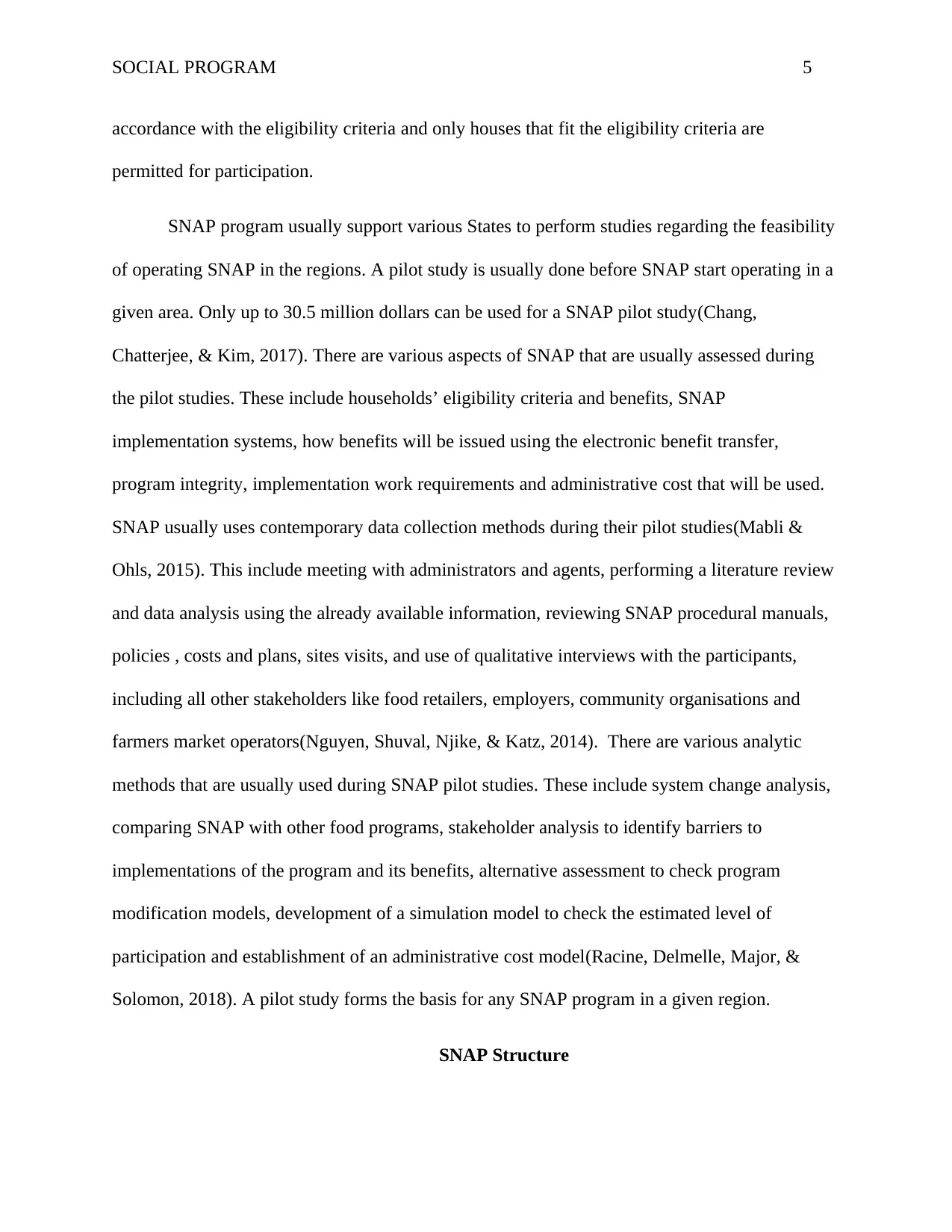
SOCIAL PROGRAM 5
accordance with the eligibility criteria and only houses that fit the eligibility criteria are
permitted for participation.
SNAP program usually support various States to perform studies regarding the feasibility
of operating SNAP in the regions. A pilot study is usually done before SNAP start operating in a
given area. Only up to 30.5 million dollars can be used for a SNAP pilot study(Chang,
Chatterjee, & Kim, 2017). There are various aspects of SNAP that are usually assessed during
the pilot studies. These include households’ eligibility criteria and benefits, SNAP
implementation systems, how benefits will be issued using the electronic benefit transfer,
program integrity, implementation work requirements and administrative cost that will be used.
SNAP usually uses contemporary data collection methods during their pilot studies(Mabli &
Ohls, 2015). This include meeting with administrators and agents, performing a literature review
and data analysis using the already available information, reviewing SNAP procedural manuals,
policies , costs and plans, sites visits, and use of qualitative interviews with the participants,
including all other stakeholders like food retailers, employers, community organisations and
farmers market operators(Nguyen, Shuval, Njike, & Katz, 2014). There are various analytic
methods that are usually used during SNAP pilot studies. These include system change analysis,
comparing SNAP with other food programs, stakeholder analysis to identify barriers to
implementations of the program and its benefits, alternative assessment to check program
modification models, development of a simulation model to check the estimated level of
participation and establishment of an administrative cost model(Racine, Delmelle, Major, &
Solomon, 2018). A pilot study forms the basis for any SNAP program in a given region.
SNAP Structure
accordance with the eligibility criteria and only houses that fit the eligibility criteria are
permitted for participation.
SNAP program usually support various States to perform studies regarding the feasibility
of operating SNAP in the regions. A pilot study is usually done before SNAP start operating in a
given area. Only up to 30.5 million dollars can be used for a SNAP pilot study(Chang,
Chatterjee, & Kim, 2017). There are various aspects of SNAP that are usually assessed during
the pilot studies. These include households’ eligibility criteria and benefits, SNAP
implementation systems, how benefits will be issued using the electronic benefit transfer,
program integrity, implementation work requirements and administrative cost that will be used.
SNAP usually uses contemporary data collection methods during their pilot studies(Mabli &
Ohls, 2015). This include meeting with administrators and agents, performing a literature review
and data analysis using the already available information, reviewing SNAP procedural manuals,
policies , costs and plans, sites visits, and use of qualitative interviews with the participants,
including all other stakeholders like food retailers, employers, community organisations and
farmers market operators(Nguyen, Shuval, Njike, & Katz, 2014). There are various analytic
methods that are usually used during SNAP pilot studies. These include system change analysis,
comparing SNAP with other food programs, stakeholder analysis to identify barriers to
implementations of the program and its benefits, alternative assessment to check program
modification models, development of a simulation model to check the estimated level of
participation and establishment of an administrative cost model(Racine, Delmelle, Major, &
Solomon, 2018). A pilot study forms the basis for any SNAP program in a given region.
SNAP Structure
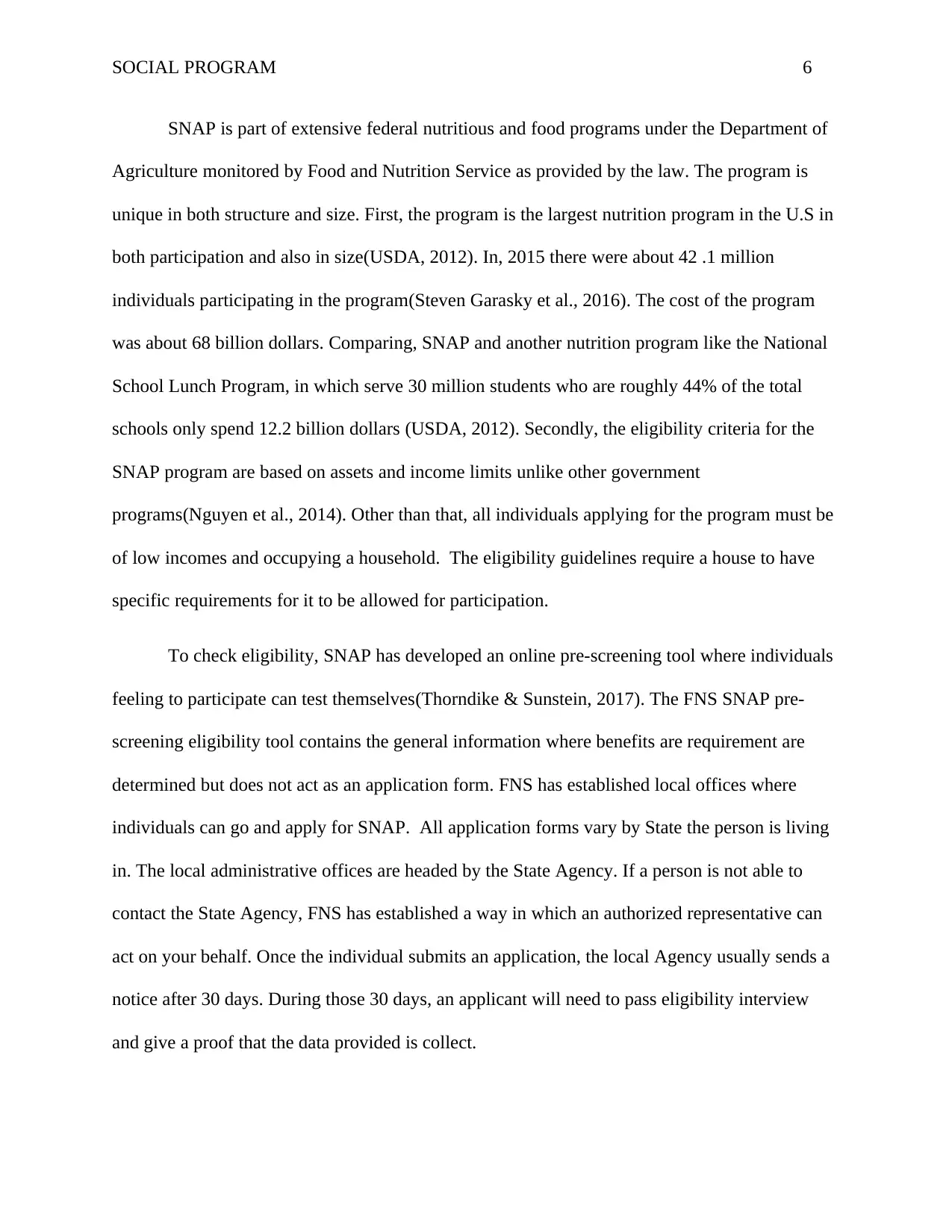
SOCIAL PROGRAM 6
SNAP is part of extensive federal nutritious and food programs under the Department of
Agriculture monitored by Food and Nutrition Service as provided by the law. The program is
unique in both structure and size. First, the program is the largest nutrition program in the U.S in
both participation and also in size(USDA, 2012). In, 2015 there were about 42 .1 million
individuals participating in the program(Steven Garasky et al., 2016). The cost of the program
was about 68 billion dollars. Comparing, SNAP and another nutrition program like the National
School Lunch Program, in which serve 30 million students who are roughly 44% of the total
schools only spend 12.2 billion dollars (USDA, 2012). Secondly, the eligibility criteria for the
SNAP program are based on assets and income limits unlike other government
programs(Nguyen et al., 2014). Other than that, all individuals applying for the program must be
of low incomes and occupying a household. The eligibility guidelines require a house to have
specific requirements for it to be allowed for participation.
To check eligibility, SNAP has developed an online pre-screening tool where individuals
feeling to participate can test themselves(Thorndike & Sunstein, 2017). The FNS SNAP pre-
screening eligibility tool contains the general information where benefits are requirement are
determined but does not act as an application form. FNS has established local offices where
individuals can go and apply for SNAP. All application forms vary by State the person is living
in. The local administrative offices are headed by the State Agency. If a person is not able to
contact the State Agency, FNS has established a way in which an authorized representative can
act on your behalf. Once the individual submits an application, the local Agency usually sends a
notice after 30 days. During those 30 days, an applicant will need to pass eligibility interview
and give a proof that the data provided is collect.
SNAP is part of extensive federal nutritious and food programs under the Department of
Agriculture monitored by Food and Nutrition Service as provided by the law. The program is
unique in both structure and size. First, the program is the largest nutrition program in the U.S in
both participation and also in size(USDA, 2012). In, 2015 there were about 42 .1 million
individuals participating in the program(Steven Garasky et al., 2016). The cost of the program
was about 68 billion dollars. Comparing, SNAP and another nutrition program like the National
School Lunch Program, in which serve 30 million students who are roughly 44% of the total
schools only spend 12.2 billion dollars (USDA, 2012). Secondly, the eligibility criteria for the
SNAP program are based on assets and income limits unlike other government
programs(Nguyen et al., 2014). Other than that, all individuals applying for the program must be
of low incomes and occupying a household. The eligibility guidelines require a house to have
specific requirements for it to be allowed for participation.
To check eligibility, SNAP has developed an online pre-screening tool where individuals
feeling to participate can test themselves(Thorndike & Sunstein, 2017). The FNS SNAP pre-
screening eligibility tool contains the general information where benefits are requirement are
determined but does not act as an application form. FNS has established local offices where
individuals can go and apply for SNAP. All application forms vary by State the person is living
in. The local administrative offices are headed by the State Agency. If a person is not able to
contact the State Agency, FNS has established a way in which an authorized representative can
act on your behalf. Once the individual submits an application, the local Agency usually sends a
notice after 30 days. During those 30 days, an applicant will need to pass eligibility interview
and give a proof that the data provided is collect.
⊘ This is a preview!⊘
Do you want full access?
Subscribe today to unlock all pages.

Trusted by 1+ million students worldwide
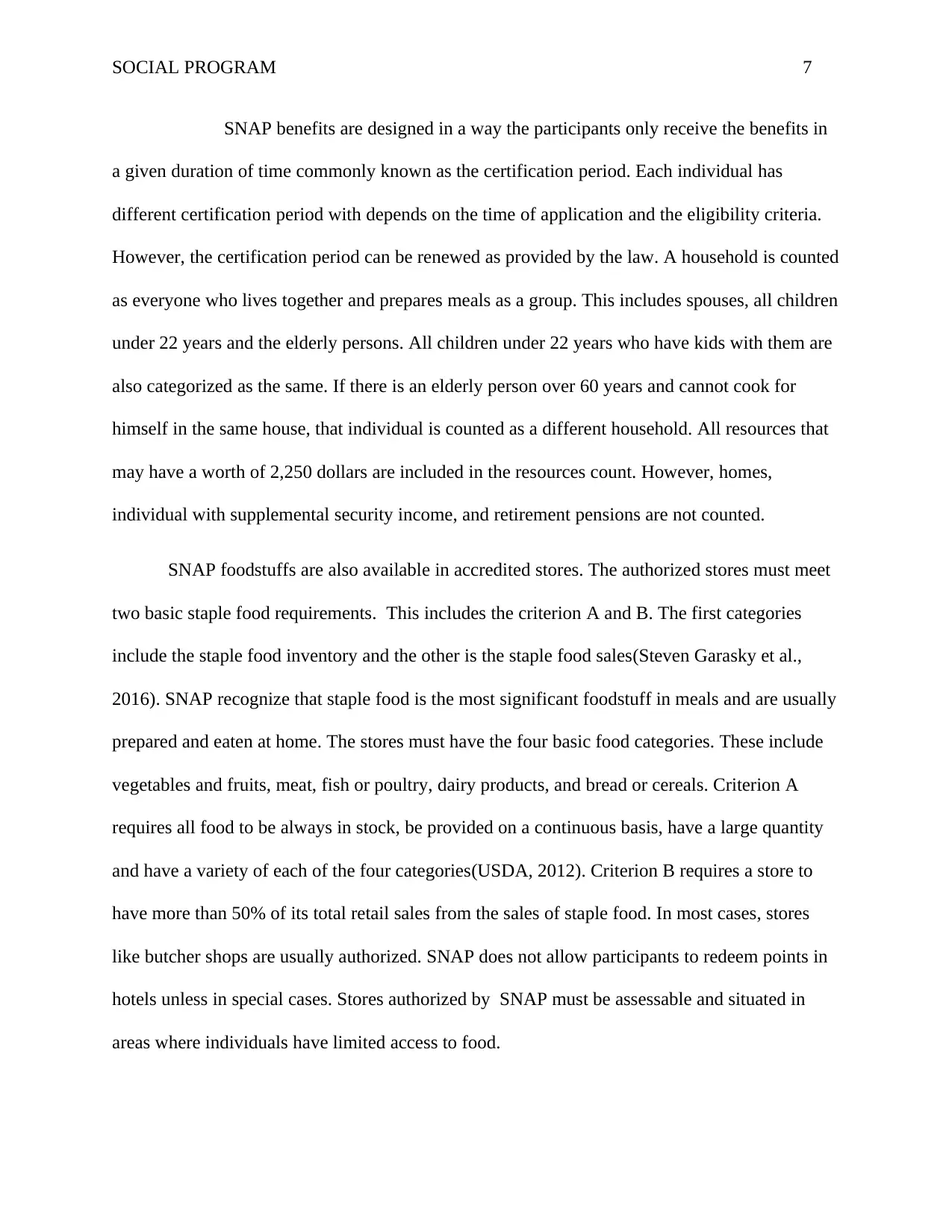
SOCIAL PROGRAM 7
SNAP benefits are designed in a way the participants only receive the benefits in
a given duration of time commonly known as the certification period. Each individual has
different certification period with depends on the time of application and the eligibility criteria.
However, the certification period can be renewed as provided by the law. A household is counted
as everyone who lives together and prepares meals as a group. This includes spouses, all children
under 22 years and the elderly persons. All children under 22 years who have kids with them are
also categorized as the same. If there is an elderly person over 60 years and cannot cook for
himself in the same house, that individual is counted as a different household. All resources that
may have a worth of 2,250 dollars are included in the resources count. However, homes,
individual with supplemental security income, and retirement pensions are not counted.
SNAP foodstuffs are also available in accredited stores. The authorized stores must meet
two basic staple food requirements. This includes the criterion A and B. The first categories
include the staple food inventory and the other is the staple food sales(Steven Garasky et al.,
2016). SNAP recognize that staple food is the most significant foodstuff in meals and are usually
prepared and eaten at home. The stores must have the four basic food categories. These include
vegetables and fruits, meat, fish or poultry, dairy products, and bread or cereals. Criterion A
requires all food to be always in stock, be provided on a continuous basis, have a large quantity
and have a variety of each of the four categories(USDA, 2012). Criterion B requires a store to
have more than 50% of its total retail sales from the sales of staple food. In most cases, stores
like butcher shops are usually authorized. SNAP does not allow participants to redeem points in
hotels unless in special cases. Stores authorized by SNAP must be assessable and situated in
areas where individuals have limited access to food.
SNAP benefits are designed in a way the participants only receive the benefits in
a given duration of time commonly known as the certification period. Each individual has
different certification period with depends on the time of application and the eligibility criteria.
However, the certification period can be renewed as provided by the law. A household is counted
as everyone who lives together and prepares meals as a group. This includes spouses, all children
under 22 years and the elderly persons. All children under 22 years who have kids with them are
also categorized as the same. If there is an elderly person over 60 years and cannot cook for
himself in the same house, that individual is counted as a different household. All resources that
may have a worth of 2,250 dollars are included in the resources count. However, homes,
individual with supplemental security income, and retirement pensions are not counted.
SNAP foodstuffs are also available in accredited stores. The authorized stores must meet
two basic staple food requirements. This includes the criterion A and B. The first categories
include the staple food inventory and the other is the staple food sales(Steven Garasky et al.,
2016). SNAP recognize that staple food is the most significant foodstuff in meals and are usually
prepared and eaten at home. The stores must have the four basic food categories. These include
vegetables and fruits, meat, fish or poultry, dairy products, and bread or cereals. Criterion A
requires all food to be always in stock, be provided on a continuous basis, have a large quantity
and have a variety of each of the four categories(USDA, 2012). Criterion B requires a store to
have more than 50% of its total retail sales from the sales of staple food. In most cases, stores
like butcher shops are usually authorized. SNAP does not allow participants to redeem points in
hotels unless in special cases. Stores authorized by SNAP must be assessable and situated in
areas where individuals have limited access to food.
Paraphrase This Document
Need a fresh take? Get an instant paraphrase of this document with our AI Paraphraser
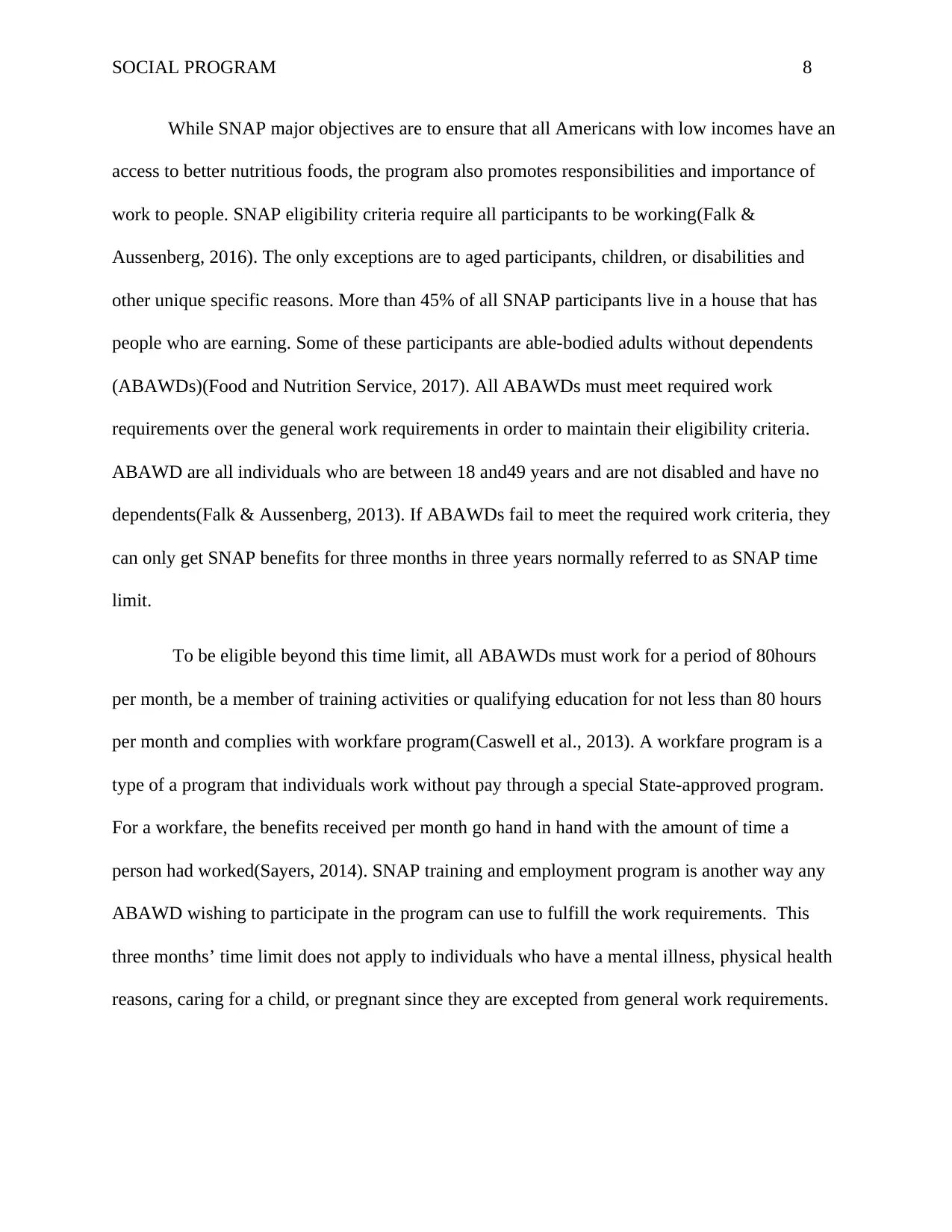
SOCIAL PROGRAM 8
While SNAP major objectives are to ensure that all Americans with low incomes have an
access to better nutritious foods, the program also promotes responsibilities and importance of
work to people. SNAP eligibility criteria require all participants to be working(Falk &
Aussenberg, 2016). The only exceptions are to aged participants, children, or disabilities and
other unique specific reasons. More than 45% of all SNAP participants live in a house that has
people who are earning. Some of these participants are able-bodied adults without dependents
(ABAWDs)(Food and Nutrition Service, 2017). All ABAWDs must meet required work
requirements over the general work requirements in order to maintain their eligibility criteria.
ABAWD are all individuals who are between 18 and49 years and are not disabled and have no
dependents(Falk & Aussenberg, 2013). If ABAWDs fail to meet the required work criteria, they
can only get SNAP benefits for three months in three years normally referred to as SNAP time
limit.
To be eligible beyond this time limit, all ABAWDs must work for a period of 80hours
per month, be a member of training activities or qualifying education for not less than 80 hours
per month and complies with workfare program(Caswell et al., 2013). A workfare program is a
type of a program that individuals work without pay through a special State-approved program.
For a workfare, the benefits received per month go hand in hand with the amount of time a
person had worked(Sayers, 2014). SNAP training and employment program is another way any
ABAWD wishing to participate in the program can use to fulfill the work requirements. This
three months’ time limit does not apply to individuals who have a mental illness, physical health
reasons, caring for a child, or pregnant since they are excepted from general work requirements.
While SNAP major objectives are to ensure that all Americans with low incomes have an
access to better nutritious foods, the program also promotes responsibilities and importance of
work to people. SNAP eligibility criteria require all participants to be working(Falk &
Aussenberg, 2016). The only exceptions are to aged participants, children, or disabilities and
other unique specific reasons. More than 45% of all SNAP participants live in a house that has
people who are earning. Some of these participants are able-bodied adults without dependents
(ABAWDs)(Food and Nutrition Service, 2017). All ABAWDs must meet required work
requirements over the general work requirements in order to maintain their eligibility criteria.
ABAWD are all individuals who are between 18 and49 years and are not disabled and have no
dependents(Falk & Aussenberg, 2013). If ABAWDs fail to meet the required work criteria, they
can only get SNAP benefits for three months in three years normally referred to as SNAP time
limit.
To be eligible beyond this time limit, all ABAWDs must work for a period of 80hours
per month, be a member of training activities or qualifying education for not less than 80 hours
per month and complies with workfare program(Caswell et al., 2013). A workfare program is a
type of a program that individuals work without pay through a special State-approved program.
For a workfare, the benefits received per month go hand in hand with the amount of time a
person had worked(Sayers, 2014). SNAP training and employment program is another way any
ABAWD wishing to participate in the program can use to fulfill the work requirements. This
three months’ time limit does not apply to individuals who have a mental illness, physical health
reasons, caring for a child, or pregnant since they are excepted from general work requirements.
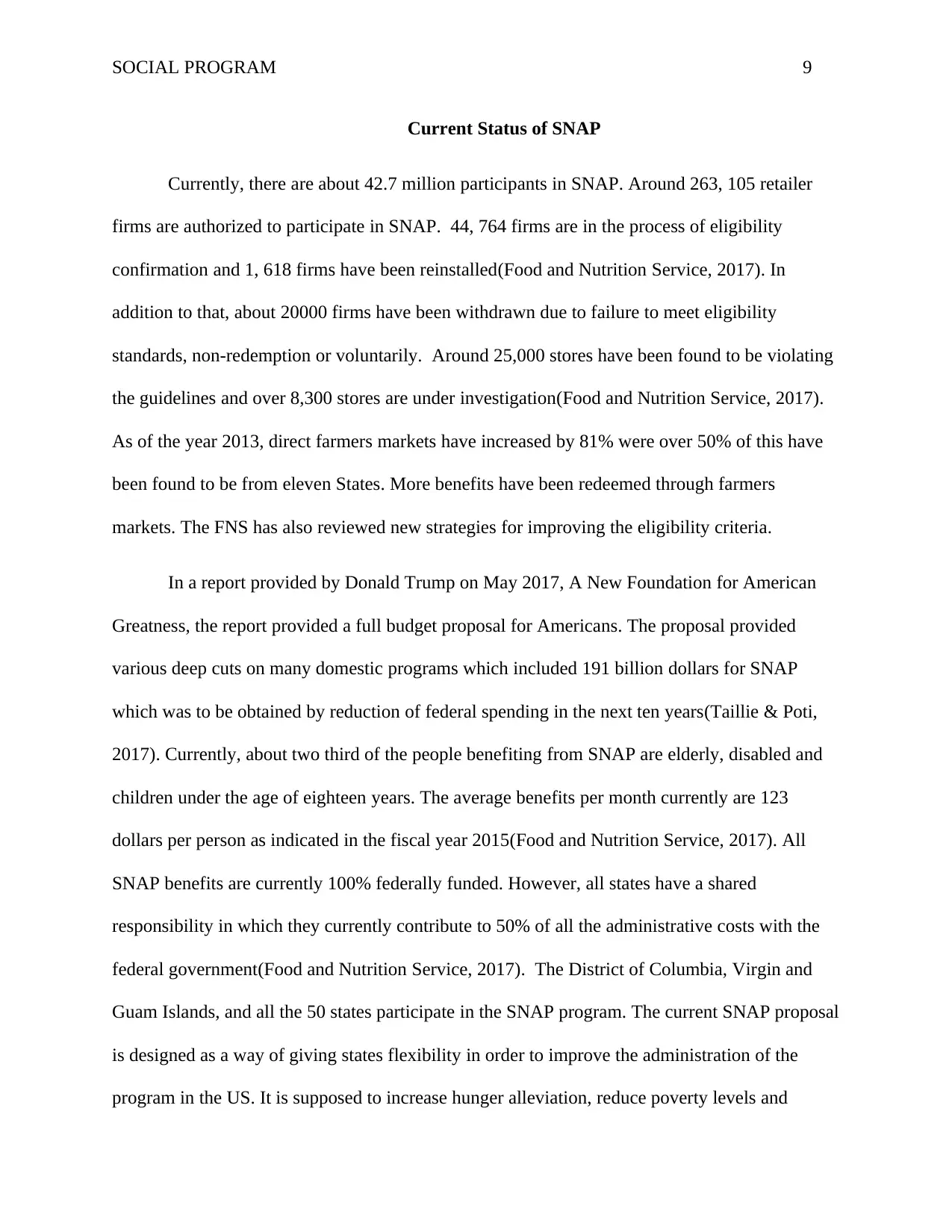
SOCIAL PROGRAM 9
Current Status of SNAP
Currently, there are about 42.7 million participants in SNAP. Around 263, 105 retailer
firms are authorized to participate in SNAP. 44, 764 firms are in the process of eligibility
confirmation and 1, 618 firms have been reinstalled(Food and Nutrition Service, 2017). In
addition to that, about 20000 firms have been withdrawn due to failure to meet eligibility
standards, non-redemption or voluntarily. Around 25,000 stores have been found to be violating
the guidelines and over 8,300 stores are under investigation(Food and Nutrition Service, 2017).
As of the year 2013, direct farmers markets have increased by 81% were over 50% of this have
been found to be from eleven States. More benefits have been redeemed through farmers
markets. The FNS has also reviewed new strategies for improving the eligibility criteria.
In a report provided by Donald Trump on May 2017, A New Foundation for American
Greatness, the report provided a full budget proposal for Americans. The proposal provided
various deep cuts on many domestic programs which included 191 billion dollars for SNAP
which was to be obtained by reduction of federal spending in the next ten years(Taillie & Poti,
2017). Currently, about two third of the people benefiting from SNAP are elderly, disabled and
children under the age of eighteen years. The average benefits per month currently are 123
dollars per person as indicated in the fiscal year 2015(Food and Nutrition Service, 2017). All
SNAP benefits are currently 100% federally funded. However, all states have a shared
responsibility in which they currently contribute to 50% of all the administrative costs with the
federal government(Food and Nutrition Service, 2017). The District of Columbia, Virgin and
Guam Islands, and all the 50 states participate in the SNAP program. The current SNAP proposal
is designed as a way of giving states flexibility in order to improve the administration of the
program in the US. It is supposed to increase hunger alleviation, reduce poverty levels and
Current Status of SNAP
Currently, there are about 42.7 million participants in SNAP. Around 263, 105 retailer
firms are authorized to participate in SNAP. 44, 764 firms are in the process of eligibility
confirmation and 1, 618 firms have been reinstalled(Food and Nutrition Service, 2017). In
addition to that, about 20000 firms have been withdrawn due to failure to meet eligibility
standards, non-redemption or voluntarily. Around 25,000 stores have been found to be violating
the guidelines and over 8,300 stores are under investigation(Food and Nutrition Service, 2017).
As of the year 2013, direct farmers markets have increased by 81% were over 50% of this have
been found to be from eleven States. More benefits have been redeemed through farmers
markets. The FNS has also reviewed new strategies for improving the eligibility criteria.
In a report provided by Donald Trump on May 2017, A New Foundation for American
Greatness, the report provided a full budget proposal for Americans. The proposal provided
various deep cuts on many domestic programs which included 191 billion dollars for SNAP
which was to be obtained by reduction of federal spending in the next ten years(Taillie & Poti,
2017). Currently, about two third of the people benefiting from SNAP are elderly, disabled and
children under the age of eighteen years. The average benefits per month currently are 123
dollars per person as indicated in the fiscal year 2015(Food and Nutrition Service, 2017). All
SNAP benefits are currently 100% federally funded. However, all states have a shared
responsibility in which they currently contribute to 50% of all the administrative costs with the
federal government(Food and Nutrition Service, 2017). The District of Columbia, Virgin and
Guam Islands, and all the 50 states participate in the SNAP program. The current SNAP proposal
is designed as a way of giving states flexibility in order to improve the administration of the
program in the US. It is supposed to increase hunger alleviation, reduce poverty levels and
⊘ This is a preview!⊘
Do you want full access?
Subscribe today to unlock all pages.

Trusted by 1+ million students worldwide
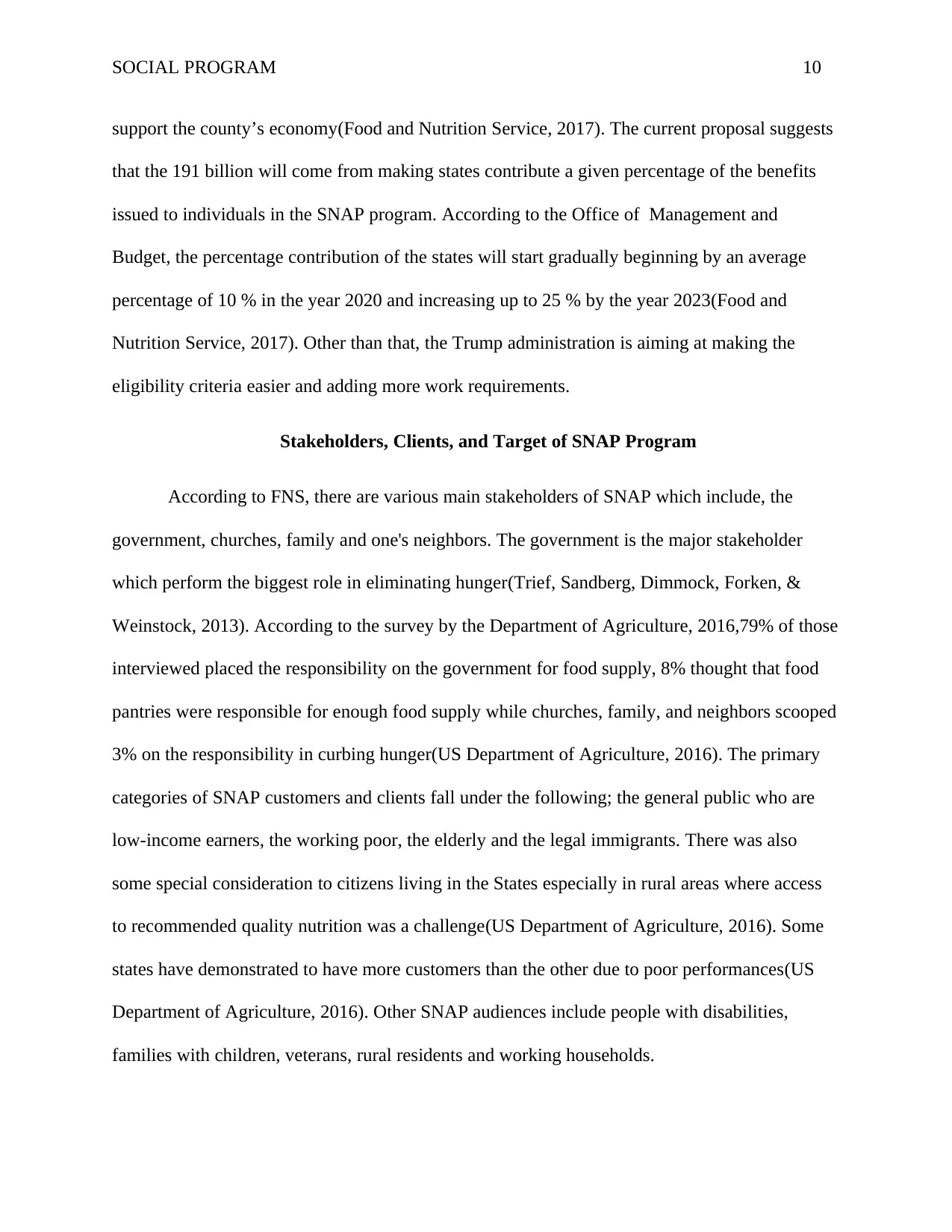
SOCIAL PROGRAM 10
support the county’s economy(Food and Nutrition Service, 2017). The current proposal suggests
that the 191 billion will come from making states contribute a given percentage of the benefits
issued to individuals in the SNAP program. According to the Office of Management and
Budget, the percentage contribution of the states will start gradually beginning by an average
percentage of 10 % in the year 2020 and increasing up to 25 % by the year 2023(Food and
Nutrition Service, 2017). Other than that, the Trump administration is aiming at making the
eligibility criteria easier and adding more work requirements.
Stakeholders, Clients, and Target of SNAP Program
According to FNS, there are various main stakeholders of SNAP which include, the
government, churches, family and one's neighbors. The government is the major stakeholder
which perform the biggest role in eliminating hunger(Trief, Sandberg, Dimmock, Forken, &
Weinstock, 2013). According to the survey by the Department of Agriculture, 2016,79% of those
interviewed placed the responsibility on the government for food supply, 8% thought that food
pantries were responsible for enough food supply while churches, family, and neighbors scooped
3% on the responsibility in curbing hunger(US Department of Agriculture, 2016). The primary
categories of SNAP customers and clients fall under the following; the general public who are
low-income earners, the working poor, the elderly and the legal immigrants. There was also
some special consideration to citizens living in the States especially in rural areas where access
to recommended quality nutrition was a challenge(US Department of Agriculture, 2016). Some
states have demonstrated to have more customers than the other due to poor performances(US
Department of Agriculture, 2016). Other SNAP audiences include people with disabilities,
families with children, veterans, rural residents and working households.
support the county’s economy(Food and Nutrition Service, 2017). The current proposal suggests
that the 191 billion will come from making states contribute a given percentage of the benefits
issued to individuals in the SNAP program. According to the Office of Management and
Budget, the percentage contribution of the states will start gradually beginning by an average
percentage of 10 % in the year 2020 and increasing up to 25 % by the year 2023(Food and
Nutrition Service, 2017). Other than that, the Trump administration is aiming at making the
eligibility criteria easier and adding more work requirements.
Stakeholders, Clients, and Target of SNAP Program
According to FNS, there are various main stakeholders of SNAP which include, the
government, churches, family and one's neighbors. The government is the major stakeholder
which perform the biggest role in eliminating hunger(Trief, Sandberg, Dimmock, Forken, &
Weinstock, 2013). According to the survey by the Department of Agriculture, 2016,79% of those
interviewed placed the responsibility on the government for food supply, 8% thought that food
pantries were responsible for enough food supply while churches, family, and neighbors scooped
3% on the responsibility in curbing hunger(US Department of Agriculture, 2016). The primary
categories of SNAP customers and clients fall under the following; the general public who are
low-income earners, the working poor, the elderly and the legal immigrants. There was also
some special consideration to citizens living in the States especially in rural areas where access
to recommended quality nutrition was a challenge(US Department of Agriculture, 2016). Some
states have demonstrated to have more customers than the other due to poor performances(US
Department of Agriculture, 2016). Other SNAP audiences include people with disabilities,
families with children, veterans, rural residents and working households.
Paraphrase This Document
Need a fresh take? Get an instant paraphrase of this document with our AI Paraphraser
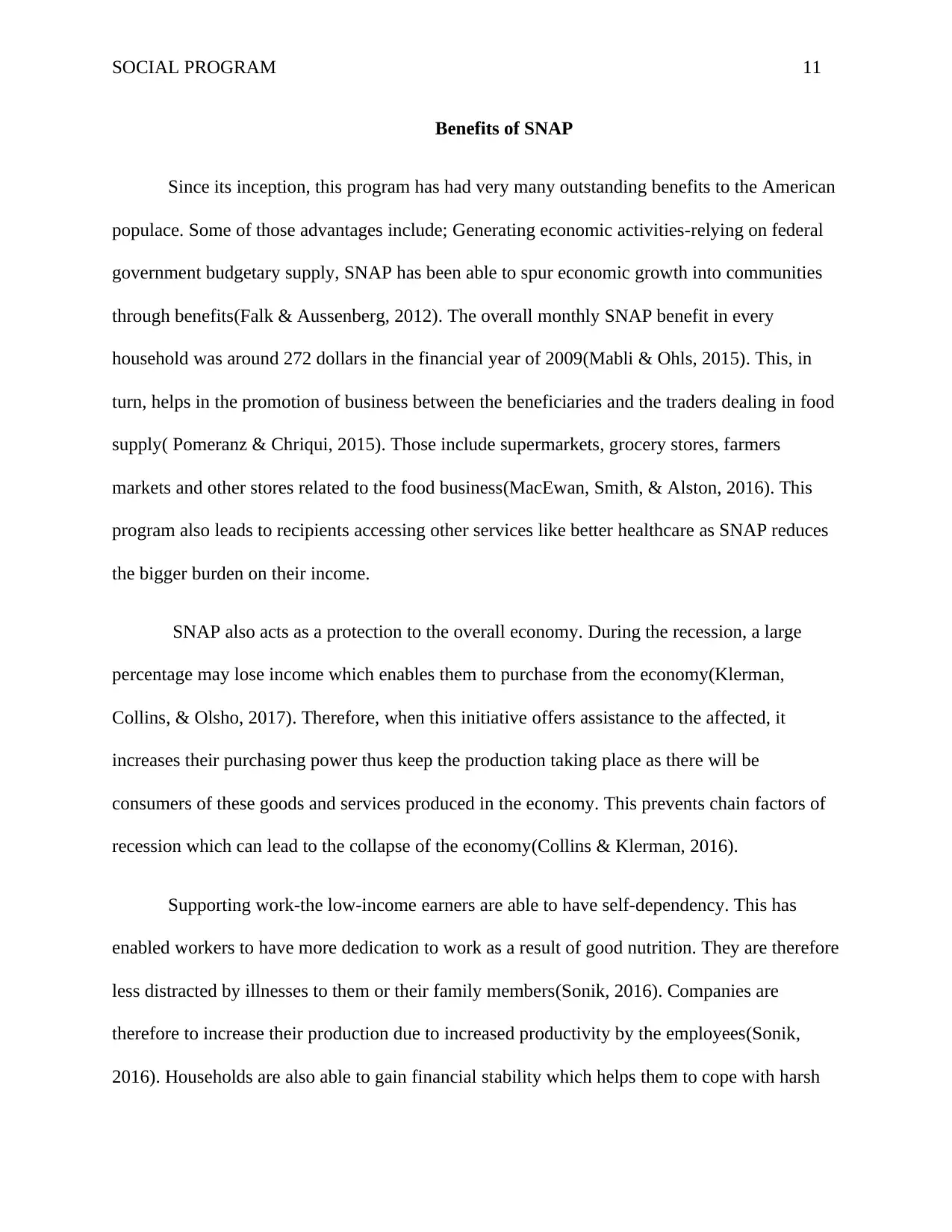
SOCIAL PROGRAM 11
Benefits of SNAP
Since its inception, this program has had very many outstanding benefits to the American
populace. Some of those advantages include; Generating economic activities-relying on federal
government budgetary supply, SNAP has been able to spur economic growth into communities
through benefits(Falk & Aussenberg, 2012). The overall monthly SNAP benefit in every
household was around 272 dollars in the financial year of 2009(Mabli & Ohls, 2015). This, in
turn, helps in the promotion of business between the beneficiaries and the traders dealing in food
supply( Pomeranz & Chriqui, 2015). Those include supermarkets, grocery stores, farmers
markets and other stores related to the food business(MacEwan, Smith, & Alston, 2016). This
program also leads to recipients accessing other services like better healthcare as SNAP reduces
the bigger burden on their income.
SNAP also acts as a protection to the overall economy. During the recession, a large
percentage may lose income which enables them to purchase from the economy(Klerman,
Collins, & Olsho, 2017). Therefore, when this initiative offers assistance to the affected, it
increases their purchasing power thus keep the production taking place as there will be
consumers of these goods and services produced in the economy. This prevents chain factors of
recession which can lead to the collapse of the economy(Collins & Klerman, 2016).
Supporting work-the low-income earners are able to have self-dependency. This has
enabled workers to have more dedication to work as a result of good nutrition. They are therefore
less distracted by illnesses to them or their family members(Sonik, 2016). Companies are
therefore to increase their production due to increased productivity by the employees(Sonik,
2016). Households are also able to gain financial stability which helps them to cope with harsh
Benefits of SNAP
Since its inception, this program has had very many outstanding benefits to the American
populace. Some of those advantages include; Generating economic activities-relying on federal
government budgetary supply, SNAP has been able to spur economic growth into communities
through benefits(Falk & Aussenberg, 2012). The overall monthly SNAP benefit in every
household was around 272 dollars in the financial year of 2009(Mabli & Ohls, 2015). This, in
turn, helps in the promotion of business between the beneficiaries and the traders dealing in food
supply( Pomeranz & Chriqui, 2015). Those include supermarkets, grocery stores, farmers
markets and other stores related to the food business(MacEwan, Smith, & Alston, 2016). This
program also leads to recipients accessing other services like better healthcare as SNAP reduces
the bigger burden on their income.
SNAP also acts as a protection to the overall economy. During the recession, a large
percentage may lose income which enables them to purchase from the economy(Klerman,
Collins, & Olsho, 2017). Therefore, when this initiative offers assistance to the affected, it
increases their purchasing power thus keep the production taking place as there will be
consumers of these goods and services produced in the economy. This prevents chain factors of
recession which can lead to the collapse of the economy(Collins & Klerman, 2016).
Supporting work-the low-income earners are able to have self-dependency. This has
enabled workers to have more dedication to work as a result of good nutrition. They are therefore
less distracted by illnesses to them or their family members(Sonik, 2016). Companies are
therefore to increase their production due to increased productivity by the employees(Sonik,
2016). Households are also able to gain financial stability which helps them to cope with harsh
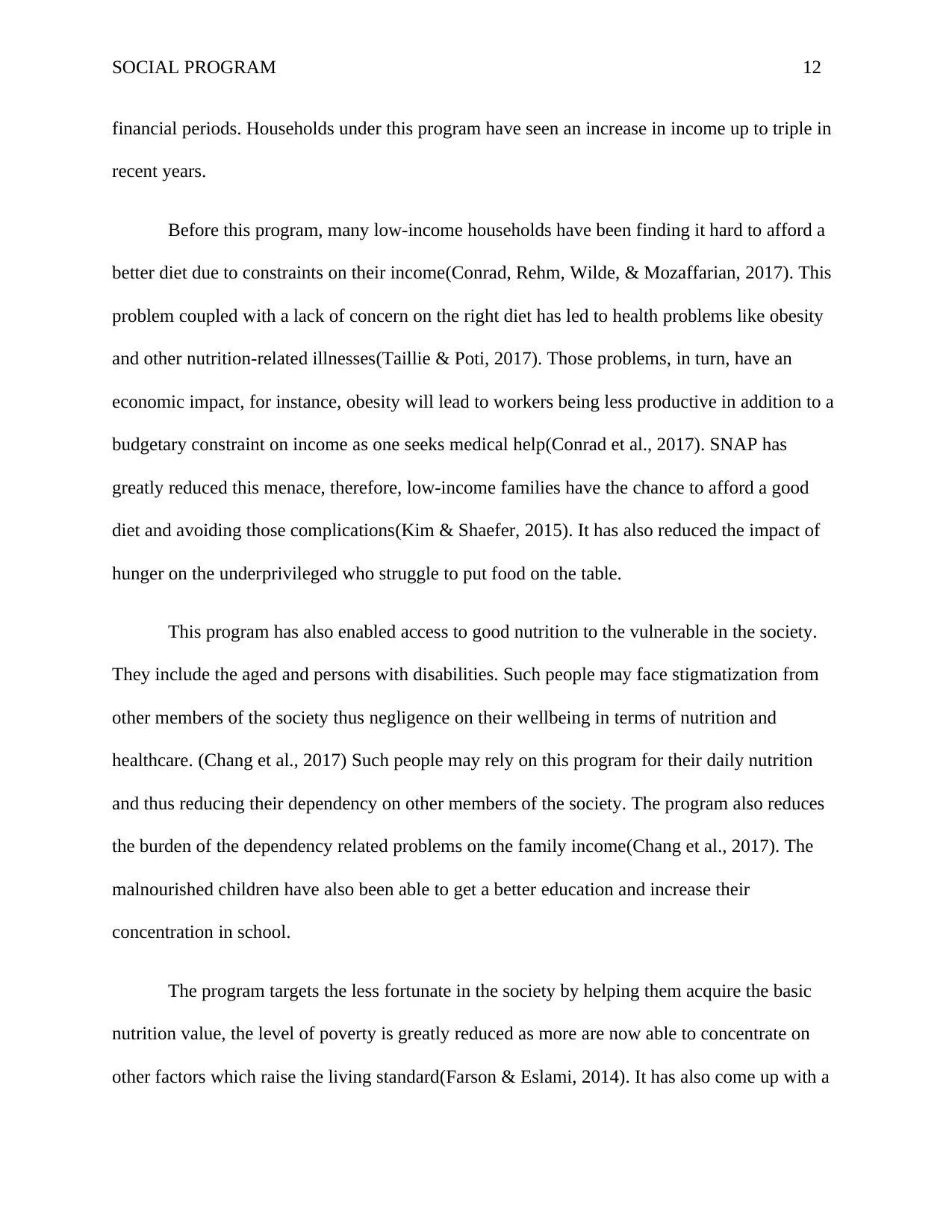
SOCIAL PROGRAM 12
financial periods. Households under this program have seen an increase in income up to triple in
recent years.
Before this program, many low-income households have been finding it hard to afford a
better diet due to constraints on their income(Conrad, Rehm, Wilde, & Mozaffarian, 2017). This
problem coupled with a lack of concern on the right diet has led to health problems like obesity
and other nutrition-related illnesses(Taillie & Poti, 2017). Those problems, in turn, have an
economic impact, for instance, obesity will lead to workers being less productive in addition to a
budgetary constraint on income as one seeks medical help(Conrad et al., 2017). SNAP has
greatly reduced this menace, therefore, low-income families have the chance to afford a good
diet and avoiding those complications(Kim & Shaefer, 2015). It has also reduced the impact of
hunger on the underprivileged who struggle to put food on the table.
This program has also enabled access to good nutrition to the vulnerable in the society.
They include the aged and persons with disabilities. Such people may face stigmatization from
other members of the society thus negligence on their wellbeing in terms of nutrition and
healthcare. (Chang et al., 2017) Such people may rely on this program for their daily nutrition
and thus reducing their dependency on other members of the society. The program also reduces
the burden of the dependency related problems on the family income(Chang et al., 2017). The
malnourished children have also been able to get a better education and increase their
concentration in school.
The program targets the less fortunate in the society by helping them acquire the basic
nutrition value, the level of poverty is greatly reduced as more are now able to concentrate on
other factors which raise the living standard(Farson & Eslami, 2014). It has also come up with a
financial periods. Households under this program have seen an increase in income up to triple in
recent years.
Before this program, many low-income households have been finding it hard to afford a
better diet due to constraints on their income(Conrad, Rehm, Wilde, & Mozaffarian, 2017). This
problem coupled with a lack of concern on the right diet has led to health problems like obesity
and other nutrition-related illnesses(Taillie & Poti, 2017). Those problems, in turn, have an
economic impact, for instance, obesity will lead to workers being less productive in addition to a
budgetary constraint on income as one seeks medical help(Conrad et al., 2017). SNAP has
greatly reduced this menace, therefore, low-income families have the chance to afford a good
diet and avoiding those complications(Kim & Shaefer, 2015). It has also reduced the impact of
hunger on the underprivileged who struggle to put food on the table.
This program has also enabled access to good nutrition to the vulnerable in the society.
They include the aged and persons with disabilities. Such people may face stigmatization from
other members of the society thus negligence on their wellbeing in terms of nutrition and
healthcare. (Chang et al., 2017) Such people may rely on this program for their daily nutrition
and thus reducing their dependency on other members of the society. The program also reduces
the burden of the dependency related problems on the family income(Chang et al., 2017). The
malnourished children have also been able to get a better education and increase their
concentration in school.
The program targets the less fortunate in the society by helping them acquire the basic
nutrition value, the level of poverty is greatly reduced as more are now able to concentrate on
other factors which raise the living standard(Farson & Eslami, 2014). It has also come up with a
⊘ This is a preview!⊘
Do you want full access?
Subscribe today to unlock all pages.

Trusted by 1+ million students worldwide
1 out of 22
Related Documents
Your All-in-One AI-Powered Toolkit for Academic Success.
+13062052269
info@desklib.com
Available 24*7 on WhatsApp / Email
![[object Object]](/_next/static/media/star-bottom.7253800d.svg)
Unlock your academic potential
Copyright © 2020–2025 A2Z Services. All Rights Reserved. Developed and managed by ZUCOL.




